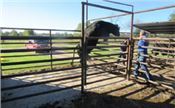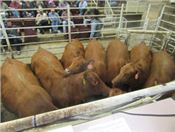|
Temperament Scoring Cattle

This animal would have a poor docility score.
ELDON COLE
MT. VERNON, MO.
If you’ve ever worked beef cattle, you know there is a difference in their attitude. You’ve probably had those that were slow-moving and easy-going with a few that border on “killers” with attack behavior.
Those latter types are the ones you look for a good reason to cull. Unfortunately, if it’s a good producing cow that calves every twelve months and raises an above average calf you may keep her around for several years waiting for her to trip up.
Cattlemen today realize life’s too short to put up with ornery, trouble-making cows, bulls, steers or heifers. In keeping with modern times and conveniences we even have some breeds that have gone the extra step to develop an expected progeny difference (EPD) to help make culling and replacement selection more objective.
The breed leader in the docility EPD project was the North American Limousin Foundation when they unveiled their program in 1994. Some of you who were around the Limousin breed remember them as being a breed that probably could stand some “genetic calming” as they were somewhat athletic. The same could be said for a few other Continental breeds and of course British breeds have a few outliers that can get excited.
Up until that time, temperament wasn’t viewed as a trait to evaluate. I did find in the 5th edition – 1986 Beef Improvement Federation Guidelines for Uniform Beef Improvement Programs, a reference to temperament codes as simply satisfactory, fair and poor. They did not quantify what number value to put on them. There was a Limousin breeder I weighed, graded and frame scored their weaned calves and I believe we just scored them as 1, 2 or 3 in 1994-95.
From that 1994 – beginning the beef industry has come a long way in evaluating something that is often referred to as a convenience trait. Many cattlemen now may even look at the docility EPD as seriously as calving ease, growth, carcass traits and milk production. It’s even included in some genomic evaluations which gives the EPD greater accuracy.
The evaluation standards have definitely become more sophisticated. The scale runs from 1 to 6. The following is a brief description of each score based on the BIF Guidelines.
1 = Docile – Mild disposition – exits chute calmly, does not pull on the headgate in chute.
2 = Restless – Quieter than average – exits chute promptly – may try to pull back on headgate – some flicking of tail.
3 = Nervous – Temperament is manageable – moderate, struggling, movement and tail flicking – exits chute briskly.
4 = Flighty (wild) – Jumpy, out of control – struggles violently – continuous tail flicking – defecates and urinates during processing – exits chute wildly.
5 = Aggressive – Similar to a 4 but with added aggressive behavior – extreme agitation and continuous movement including jumping and bellowing – exits chute frantically.
6 = Very aggressive – Thrashes about or attacks wildly in small places, pronounced attack behavior.
Docility scores are recommended to be given at weaning and/or yearling time when they’re worked through a chute. Be consistent when and under what conditions and who does the scoring. The steers we send to the Missouri Steer Feedout at the Tri-County Steer Carcass Futurity. in Iowa are scored each time they run them through the chute. Their close out, data, based on thousands of steers, shows a loss of $62 per head for those with a score of 3.0 or higher. We generally consider the heritability of temperament to be in the 35 to 40 percent range. This is considered moderate and if you feel you need to put more pressure on the trait you should be able to make progress.
Although, I do not score all of the Show-Me-Select heifers, I’ve done enough to say the trait is very repeatable. SMS heifers are not required to be exceptionally calm. However poor dispositions and aggressive behavior is not acceptable.
Even if you’re not a purebred breeder, a SMS producer or have steers in the Feedout you might use the docility/temperament scores to make cattle-working a little quieter, less dreaded, more Beef Quality Assurance (BQA) acceptable and more profitable. ∆
ELDON COLE: Extension Livestock Specialist, University of Missouri

Genomic-tested Show-Me-Select Red Angus heifers that were exceptional for docility.
|
|